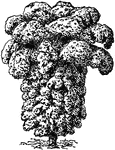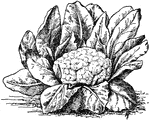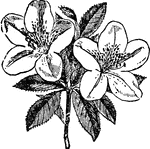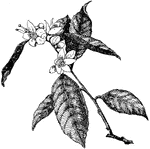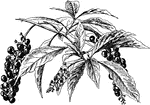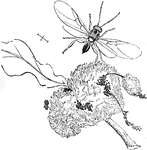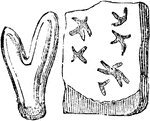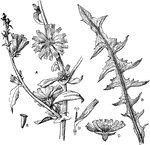
Common Chicory
"Chicory (Cichorium Intybus). A, portion of flowering branch; B, basal leaf (runcinate-pinnatifid);…

Tickseed
"A composite (Coreopsis sp.). A, B, E, views of the inflorescence or head; C, a ray-flower; D, section…
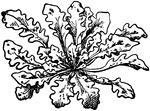
Wild Cliff-Cabbage
"Wild cliff-cabbage, hypothetical ancestor of the numerous modern horticultural forms." -Gager, 1916

Lake and Vegetation
"Diagram illustrating the gradual filling up of lakes by the encroachment of vegetation, and also the…

Marratia Fern
"Top, lateral pinna from a leaf of Marattia jraxinea. Below at left, synangium of same. At right, corss-section…

Cycadeoid
"Cycadeoidea dacotensis. Semi-diagrammatic sketch of a flower (bisporangiate cone), cut longitudinally;…
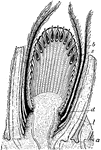
Cycadeoid
"Cycadeoidea Wielandi. Longitudinal section through the axis of a female inflorescence, or cone. l,…

Castor-oil Plant
A plant native of the Indies, the plant is used to make castor-oil, which is used as a laxative and…
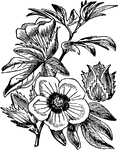
Cotton plant
The cotton plant is a shrub that produces a downy fiber, called cotton. This material is then woven…
Foxtail Grass
"Foxtail grass, the common name given to certain grasses, because of the shape of the large clusters…
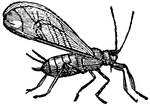
Winged Aphides, or Plant Lice
"They subsist on the sap of the tree; and are sometimes provided with wings, and are sometimes without."

Winged Aphides, or Plant Lice
"They subsist on the sap of the tree; and are sometimes provided with wings, and are sometimes without."

Wingless Aphides, or Plant Lice
"They subsist on the sap of the tree; and are sometimes provided with wings, and are sometimes without."
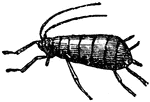
Wingless Aphides, or Plant Lice
"They subsist on the sap of the tree; and are sometimes provided with wings, and are sometimes without."

Ant and Plant Lice
Ants are very fond of a sugary liquid that Plant lice secrete. They will milk the bugs of this liquid.

Bloodroot flower
"Nature, pervades the air, where grow the modest blue-eyed violets, the fragrant trailing arbutus, spicy…
Longleaf Pine (Pinus palustris Mill.). Two-thirds natural size. epidermis of leaf (magnified)
The longleaf pine commonly found in the South Atlantic and Gulf States. The leaves are 9 to 12 inches…

Mesquit (prosopis juliflora).
The mesquit is on of the characteristic shrubs throughout the desert. It varies in size from a straggling…

Spanish bayonet (yucca baccata).
Two or three species of yucca are called Spanish bayonet. The shrub has a thick stalk about 3 or 4 feet…

Creosote bush (larrea mexicana)
The creosote is a sticky, resinous bush with small round evergreen leaves, yellow flowers, woolly fruit,…

Candlewood (fouquiera splendens).
The candlewood consists of about a dozen stalks about an inch in diameter, nearly straight, and about…
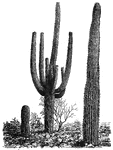
Giant Cactus (cereus giganteus).
The giant cactus is by far the largest form of vegetation in the desert. They can grow to be over 20…

Broomrape (orobanche ramosa).
An annual plant , 6 to 15 inches high, with many slender branches of a brownish or straw color, more…

Brown Alga
"Fucus platycarpus...3. jointed branching hairs detached from the sides of the conceptacle and bearing…

Common Stonewort
"1. Chara vulgaris; 2. a portion of a branch with a nucule and globule; 3. the globule more magnified;…
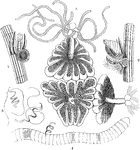
Chara fragilis
"1. Antherid and spore-case of Chara fragilis not much magnified; 2. the same at a later period, after…

Arcyria flava
Arcyria flava (or Arcyria obvelata) is a species of fungus or slime mold found in Australia.

Mucor caninus
Mucor caninus is a species of mold found in soil, on plant surfaces, and rotting vegetables.

Fungal Disease
Vermicularia trichella is a fungal plant disease that causes leaf and stem spot in English Ivy.
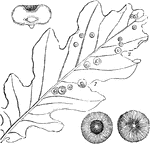
Fungal Diseas
"Mucor mucedo, very highly magnified, exhibiting 1, the spawn or mycelium." -Lindley, 1853

Cordycep
The Sphaeria sinensis a cordycep, a parasitic fungus. "The right hand figure represents the manner in…

Cordycep
The Sphaeria Robertsii a cordycep, a parasitic fungus "growing from the caterpillar of a New Zealand…

Flocci and Spores
"1. Polyplocium inquinans, divided vertically, natural size; 2. flocci and spores; 3 and 4, the same…

Fungus
"Pisomyxa racodioides, Corda.-1. Natural size; 2, the fungus greatly magnified; 3, a spore-case bursting…

Ground Pine
"1. Spore-case of Lycopodium denticulatum opened; 2. antheridium; 3. spore." -Lindley, 1853

Lichen
"1. Shields of Variolaria amara; 2, a portion of the thallus of the same plant." -Lindley, 1853
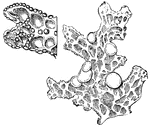
Tree Lungwort
"3. a piece of the thallus of Sticta pulmonacea, with lacunae and soredia; 4. thallus of the same, bearing…
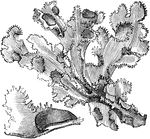
Iceland Moss
"Cetraria islandica: a a. its shields; b. a shield magnified and divided vertically." -Lindley, 1853

